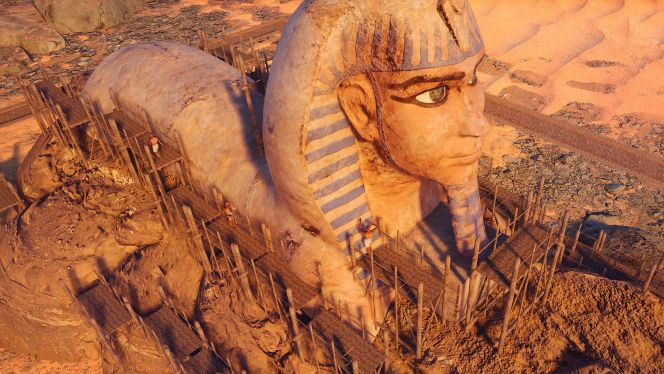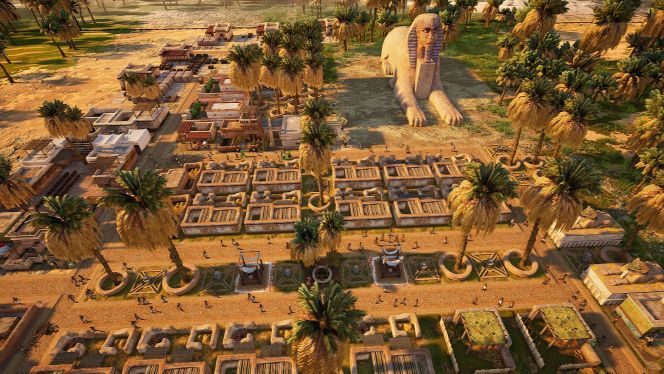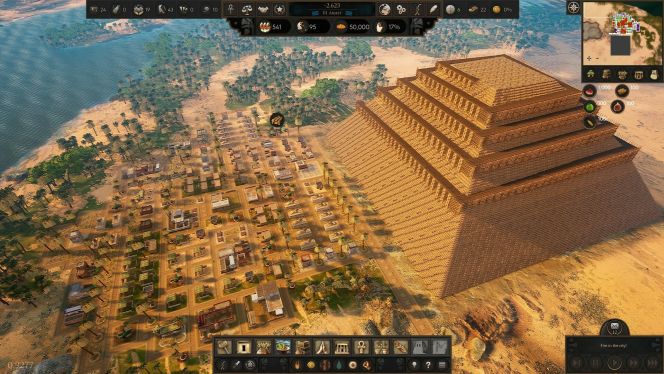REVIEW – This is a 3D simulation city-building game from Strategy Labs, where you can’t complain about the basics, but you can criticize practically every element beyond that. It has a number of problems that make its rating not very good, so it’s a typical title that will be forgotten in a short time, because even Egypt itself is not an original concept.
The Valley of the Nile, where one of mankind’s greatest and most enduring civilizations has to make its mark… not as a pharaoh, but as a city planner.
From Inebu-Hedj to Khetyu-Mefkat
The first name of a settlement under this name doesn’t say much, so we’ll just add that it’s Memphis. The city-building elements are well designed, but visually not as “clean” as they should be, which is important because it makes the gameplay less efficient. There is a story (partly inspired by real events), but this is taken care of with a long narrative at the beginning of the missions. The problem with the basics is that BoE has failed to build them in a way that makes them distinguishable from other titles in the genre. Pharaoh: A New Era comes to mind, and that’s no coincidence (and it’s no different in terms of setting and era), because the gameplay structure is lifted from there in an almost one-to-one fashion. The 3D assets and maps are nice, but there is a downside: the game requires more system power, and as your city grows, the frame rate can drop to a slide show if you don’t have a modern enough configuration. The visuals have been sacrificed on the altar of utility: the interface is boring, and we don’t immediately have the information we need (such as how many resources are available in a given location).
The music is good, and draws fairly from the ancient Egyptian foundations, but the sound is marred by the narrator’s boring delivery and the poor background sounds. The gameplay, by the way, is based on proper building layout, production-oriented city management, and missions that require objectives, so it’s less sandbox. Each mission has certain tasks to be completed, and the most important will be to build production chains and maintain the systems that support these chains. Trade routes are established within the city, and there is even talk of import/export logic. The belief system is not left out. But this is understandable, because the BoE wanted to be more credible. Bread instead of gold was the currency, reinforcing the barter system that was accepted at the time. You also have to take into account the floods that happen every year and plan for them! And just in case you are not into the story mode, there is of course a sandbox mode in BoE, so for those who are not familiar with the genre, this (and the three difficulty levels) will give you a good idea of what you are capable of and how well you can meet the (rather high) expectations of the game (on the harder levels)…
Problematic on almost all levels
The difficulty of BoE lies in the need to plan carefully and efficiently. This does not penalize us, and if the “production line” breaks down somewhere, it is not automatically a game over, but it will be a challenge to turn the situation around from here if we do not have enough resources, while also taking into account the interconnected elements of our system. This flexibility is a very good thing, as is the scaling of the three difficulty levels. Despite the beautiful visuals, some buildings are almost indistinguishable from each other. This spoils the atmosphere. The other problem is the lack of grids, which only appear when you want to place a building somewhere. This makes it difficult to plan long term when playing on higher difficult levels.
The interface would have been nice a few decades earlier, because although it works, it is outdated and too much like the BoE world. The menu is a disaster. The side quests are pointless with random requests. You have to find something, click on it, but sometimes the requested things are very small or there is no help with the location. This is not Where’s Waldo?, but a city-building game. What does that have to do with the gameplay? And if anyone else wants aid, it’s the execution that’s the problem. You have to click through several menus (and the reward is not really worth it). Couldn’t this be simplified by a pop-up with a yes/no option? This would have been much more practical… and so there may be a reason why it feels oversimplified in some places and unnecessarily complicated in others.
Destruction of Egypt
Builders of Egypt gets a 6.5/10 because its flaws drag it down from the 7.5 it would have otherwise deserved, but the map design, interface, resulting lack of atmosphere, overly fancy graphics, and resulting gameplay disadvantage mean it cannot get a higher rating. It can be fun, and it’s quite deep, but the problem is that it’s not very original. It doesn’t stand out from other titles in the genre and will therefore quickly fade into obscurity. If you like the genre, a free download of the prologue is recommended.
-V-
Pros:
+ More tasks to complete on harder difficulty levels, and no punishment on easier ones
+ The city building and trade system is quite good
+ Even beginners can master the basics
Cons:
– Ridiculously bad interface
– The graphics also hurt the gameplay
– The level design is also a bit weak/strong>
Publisher: Playway S.A.
Developer: Strategy Labs
Style: city building
Release date: January 8, 2025
Builders of Egypt
Gameplay - 7.7
Graphics - 6.8
Story - 7.7
Music/Audio - 5.3
Ambience - 6.5
6.8
FAIR
There are good elements, but there are just as many bad ones, so this game doesn't stand out...


















Leave a Reply